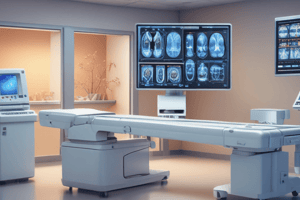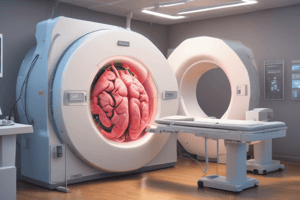Podcast
Questions and Answers
Why is collimation required during CT imaging?
Why is collimation required during CT imaging?
- To scatter radiation throughout the patient
- To make the imaging process faster
- To restrict the beam to the anatomy of interest and reduce patient radiation dose (correct)
- To increase patient radiation dose
What is the purpose of detector collimators in CT imaging?
What is the purpose of detector collimators in CT imaging?
- To widen the beam for better imaging
- To increase scattered radiation
- To reduce beam width at the detector
- To shape the beam and remove scattered radiation (correct)
How do proximal and distal collimators contribute to CT imaging?
How do proximal and distal collimators contribute to CT imaging?
- They are used to increase slice thickness
- They help restrict the beam and maintain a constant beam width at the detector (correct)
- They are used to increase patient radiation exposure
- They ensure a variable beam width at the detector
What role does the collimator section at the distal end of the assembly play in CT imaging?
What role does the collimator section at the distal end of the assembly play in CT imaging?
How can various slice thicknesses be achieved in CT imaging?
How can various slice thicknesses be achieved in CT imaging?
Flashcards are hidden until you start studying




